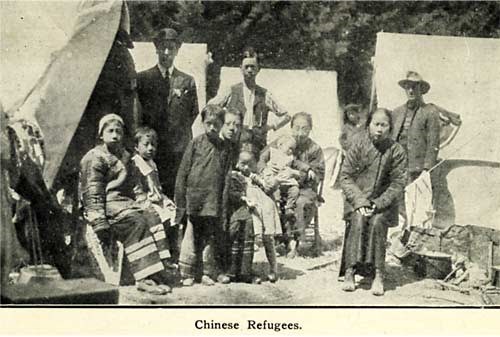|
The 1906 earthquake displaced hundreds of thousands of people throughout the San Francisco Bay Area. However, the Chinese occupants of San Francisco faced the particular threat of permanent displacement. San Francisco had attracted an Chinese labor community as a result of the 1848 Gold Rush and western expansion of the railroads. By 1870, over thirty thousand Chinese laborers had established their own San Francisco Chinese-American community - Chinatown. Their presence, however, was not particularly welcomed, as Chingwah Lee, a Chinatown historian, explains, "At the time there was no work for white men, never mind the Chinese. But the Chinese would take any work at any pay. This just increased their unpopularity." Unfortunately, the 1906 earthquake and fire afforded a convenient excuse by city officials to claim Chinatown for profitable commercial development and they attempted to drive the Chinese out of the city.

Bob Bowen Collection Even before the earthquake, some city officials wanted to move the Chinese to Hunters Point and to obtain Chinatown’s valuable land. Now they had the perfect opportunity. The estimated 15,000 Chinese living in San Francisco’s Chinatown lost nearly everything in the earthquake and fire. Following the disaster, most Chinese left for Oakland and only about 400 remained in the city. Sadly, despite a military presence in the vacated Chinatown, there was extensive looting by city residents and even National Guard troops. The Army gathered the Chinese remaining in the city and moved them to segregated camps farther and farther from Chinatown; they finally ended up in a remote, cold and windy corner of the Presidio near Fort Point. Hugh Kwong Liang, fifteen at the time, recalled, “I turned away from my dear old Chinatown for the last time... city officials directing the refugees approached us and told us to proceed toward the open grounds at the Presidio Army Post.” The plan to relocate Chinatown ultimately failed after city officials realized the city would lose tax revenues and profitable Oriental trade. After the long drawn out and failed manipulative efforts by the Committee on the Location of Chinatown, the Chinese were allowed back to rebuild Chinatown, one of the icons of San Francisco. Resources Barker, Malcolm E. Three Fearful Days, (San Francisco: Londonborn Publications, 1998). "Chinese Colony at Foot of Van Ness." San Francisco Chronicle, 27 April 1906. Museum of the City of San Francisco. http://www.sfmuseum.org. "Chinese Make Strong Protest." San Francisco Chronicle, 30 April 1906. Museum of the City of San Francisco. http://www.sfmuseum.org. Hansen, Gladys and Emmet Condon. Denial of Disaster, (San Francisco: Cameron and Company, 1989). Hansen,Gladys. "Relocation of the Chinese." Museum of the City of San Francisco, 1 June 1996. http://www.sfmuseum.org. Letter from E.S. Benton, Capt. Arty. Corps. To Military Secretary of California. "Chinese Camp." National Archives, 28 April 1906. "New Chinatown Near Fort Point." San Francisco Chronicle, 28 April 1906. Museum of the City of San Francisco. http://www.sfmuseum.org. Thomas, Gordon and Max Morgan Witts, The San Francisco Earthquake, (New York: Stein and Day, 1971). "Want Chinese on the Front." San Francisco Examiner, 4 May 1906. Museum of the City of San Francisco. http://www.sfmuseum.org. |
Last updated: February 28, 2015
